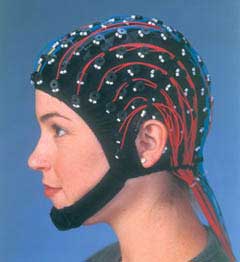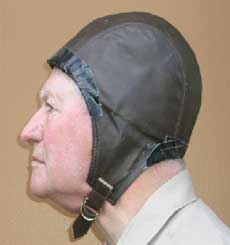From, the Thinking Person’s Guide to Autism. October 25, 2012
Our belief is that all autism approaches should mirror the physicians’ credo “First, do no harm.” But how do you determine when benefits outweigh potential damage? The pseudoscience so often promoted as “autism treatments” has a handful of consistent identifying characteristics. Ask yourself:
•Does this practitioner or vendor promise miracles that no one else seems to achieve?
The hat dramatically improved the condition of two autistic children who wore it every night for 10 years. Both children were declared hopeless autistics in 2000. They stopped wearing the hats in 2010. The boy, now 30, graduated from a community college and lives at home. The girl, now 28, is working full time. Their cousins also tried the hat for less than a year and had some results but the mother did not persevere and her children stopped wearing their hats. Parents must train their children to wear the hat for hours at a time and the hat must be worn consistently to work. The hat also helped a mute autistic girl to speak in 2003. After wearing the hat for three months she started to speak. She now has a college degree in art and is working full time. The neuro hat is improving the behavior and cognition of a nine year old boy, and the motor skills of at fourteen year old boy who now swims and rides a bicycle, and cognition for an nine year old boy with cerebral palsy.
•Is the person promising the outcome also asking me for money?
I give the hats to people to try for free. I have never charged anybody for a hat. The sleeping hats now take about 5 hours to make and the baseball caps take three hours to make. I sew them with a $1,600 industrial sewing machine for durability that I purchased with my own money.
 |
Inventor Michael Menkin sewing a Neruo Hat or “Thought Screen Helmet” with an industrial sewing machine which he bought with his own money. He gives the hats to people for free. Each leather hat takes five hours to make and costs about $45. He also makes baseball caps and "fisherman's" hats lined with velostat which he calls "Riland Hats." |
•Do I find any scientific research supporting their claims, or are there only individual (often emotional) testimonials of effects?
 |
EEG research studies electrical activity coming from the brain. All scientific studies of brain electrical activity measure activity coming from the brain. There is no hard data about the healing effect of the hat but there is an abductee who was also an epileptic with Grand Mal Seizures. After wearing the hat for three months his EEGs returned to normal and his seizures stopped several months later. He is now allowed to drive a car. His EEGs are hard data but his doctor does not believe the hat helped him. Written records of some autistic children who were helped by the hat are available from an accredited source. |
 |
There are no studies using a hat with a conductive plastic that puts the brain’s electrical activity back into it. The hats on this website are the first hats to do so. There is no scientific research on the electrical activity of the hat and how it helps heal the brain. |
 |
(left) György Buzsáki, M.D., Ph.d. Biggs Professor of Neural Sciences, NYU School of MedicineNeurophysiologist Gyorgy Buzsaki’s book, Rhythms of the Brain, discusses some of the electrical-neural processes in the brain which function rhythmically. His research focuses on the Hippocampus and may provide insight into the healing properties of hats lined with electrically conductive plastic for people with certain types of neurological disorders and brain injury. The hat may return some of the person’s electrical impulses back into the brain at the brain’s own rhythm. |
•Does the practitioner or vendor promise a blanket “cure” for unrelated disorders, such as grouping together allergies and autism; or autism and ADHD; or autism, diabetes, cancer, and allergies?
The hat has to be worn consistently to work. It took years for the hats to help autistic children. The hat began to help an epileptic after three months and eventually cured him of his grand mal seizures. The total time frame for that cure is unknown. It cured twenty people with migraine headaches. Some people were cured of migraine headaches in less than a week, others took over a year to be cured. The cure rate of people suffering from migraine headaches is about 60%. I follow each cured person for a year and they remain headache free for one year after being cured by the neuro hat. As of 2025 it is also helping brain injured persons, it helped a professional football player suffering from CTE and it cured an Iraq veteran suffering from PTSD. It is also helping three men suffering from schizophrenia.
I will respond to any established scientist who is interested in the hat.
•Does the practitioner or vendor have strong credentials as an expert in the therapies they’re promising, or in the field of autism?
I have no credentials in any kind of therapy. I have worked for many high technology companies as a technical writer and I also edited scientific papers in neurophysiology as a publications editor for the department of Neurobiology and Biophysics at the University of Washington. I retired in 2014 as a regulation writer for the Federal Aviation Administration.
Thinking critically is one of the most important actions we can take for those we love, and for ourselves. Thinking critically starts with listening critically: You will find frank autistic voices on the site, The Thinking Person’s Guide to Autism. The site shares opinions, insights, and experience on a wide range of topics. They deserve your full attention, consideration, and respect. You may also notice that many autistic contributors appear in dual or triple roles as autism parents and/or autism professionals, and that some prefer to capitalize the term Autistic.
Michael Menkin also has multiple roles as an inventor, UFO investigator, and independent medical researcher.
 |
|
At Thinking Person's Guide to Autism, we believe organizations that support autistic people must adhere to the following five principles:
1.Support, not cure: autism is a naturally occurring human neurological variation and not a disease process to be cured. Medical or health issues that may accompany autism should be addressed independently.
Autism is the fastest -growing developmental disability; it has a 1,148% growth rate which is not naturally occurring. This website now has sections showing that the epidemic of autism is caused by alien abductions. Alien activity to produce a new race that is part alien and part human has produced a global breakdown of the human genome. The annual growth rate of autism is 10% to 17% per year.
2.Evidence-based medical and clinical interventions: from our inception, we have advocated for helping autistic individuals in ways that are based on peer-reviewed empirical studies and which have been deemed effective by the wider scientific and academic communities.
I wrote to 70 scientists, research institutes and universities about the hat. Nobody was interested, not even the scientists whose papers I edited as a publications editor at the University of Washington Medical School. I worked with the traumatic brain injury support groups at Swedesh Hospital in Edmonds, Washington and Providence Medical Center in Everett, Washington, to have brain injured people try the hat. Many of those people report that the hat helps them. There are also 50 people trying the hat who were personal referrals or contacted me on the internet: 20 of those people are already cured of their migraine heaeaches.
3.Inclusiveness: Autistic people must have significant, meaningful, and primary roles in all aspects of the organization, especially at board and executive levels with regards to planning and decision-making. Displaying autistic individuals in advertisements, or claiming to support autistic self-advocacy in cases where autistics have no power within the organization is manipulative and exploitive.
The parents of autistic children who wore the hats have a working relationship with me, as do abductees who wear the hat to stop alien abductions. I do not advertise any person or device. All of my work is a public service. I participated in the meetings of the traumatic brain injury support groups at Swedish Hospital in Edmonds, Washington, and Providence Medical Center in Everett. I recruit people to try the hat through websites on the internet, personal recommendations and referrals.
4.Acceptance, not stigmatization: All aspects of the organization's financial cycle, from advertising and fundraising through grants and programs, must be driven by values of inclusion and acceptance of autistic people across the spectrum. Using fear or negative imagery to promote autism awareness degrades and isolates autistic people and their families.
I do not have an organization. I’m one person making hats with my own resources and giving them to persons with selected neurological disorders and to alien abductees to try. I contact every person in my research program once a week by phone, email, or text. I keep all of my research records myself. This website explains that aliens from space are abducting children, that aliens from space are the cause of the autism epidemic, and that we must stop aliens from abducting adults and children and subsequently stop the epidemic of autism. I have a separate nonprofit website with instructions for making hats.
5.Advocacy for the human and civil rights of all autistic people: Clear positions must be publically expressed on issues that affect the well being of autistic individuals. Such issues include the use of physical and chemical restraints; the lack of full inclusion in education, work, and housing; and funding for programs that address the immediate needs of autistic people in their communities.
This website is addressed to the world. The hat has helped autistic children, people with traumatic brain injuries, headaches, short term memory problems, CTE, cerebral palsy, schizophrenia, and PTSD, as well as stopping aliens from abducting humans. I give the hat to persons for free when they sign a consent form and a medical information form. Those messages are clear. Anybody can make a hat from the instructions on stopabductions.com.
 |
|





















